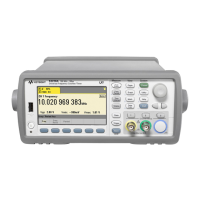MEASure:RTIMe?
Syntax
MEASure:RTIMe? [{<lower_reference> | MINimum | MAXimum | DEFault} [,{<upper_reference> |
MINimum | MAXimum | DEFault}]] [,<channel>]
Description
This query sets all measurement parameters and trigger parameters to default values for rise time meas-
urements, then immediately triggers a measurement. The results are sent directly to the instrument out-
put buffer.
Parameters
Name Type Range of Values Default Value
<lower_reference> Numeric 10 to 90 PCT (percent)
-5.125 to +5.125 V (5.125V range)
-51.25 to +51.25 V (51.25V range)
MIN = 10 PCT
MAX = 90 PCT
10 PCT
<upper_reference> Numeric 10 to 90 PCT (percent)
-5.125 to +5.125 V (5.125V range)
-51.25 to +51.25 V (51.25V range)
MIN = 10 PCT
MAX = 90 PCT
90 PCT
<channel> Expression (@1) | (@2) (@1)
Remarks
l The <lower_reference> and <upper_reference> parameters specify the input signal reference level,
either in terms of percent of peak-to-peak voltage, or in absolute voltage. To specify the level in per-
cent, use a numeric value with no suffix or with the PCT suffix; for example, 30 or 30 PCT. To specify the
level in absolute voltage, use a numeric value with the V or MV (millivolt) suffix: 100 MV or .1V.
l When either <lower_reference> or <upper_reference> is omitted or specified in percent, auto-leveling is
enabled. When specified in absolute voltage, auto-leveling is disabled.
Because this command enables auto-leveling if the reference values are omitted or spe-
cified in percent, you should specify the reference values in terms of absolute voltage if
the input frequency is lower than the minimum input signal frequency for auto-leveling
(see SYSTem:ALEVel:FREQuency command).
l If <lower_reference> is greater than <upper_reference>, no error is generated, but the measurement res-
ult is undefined.
Keysight 53220A/53230A Programmer's Reference 271
MEASure:RTIMe?

